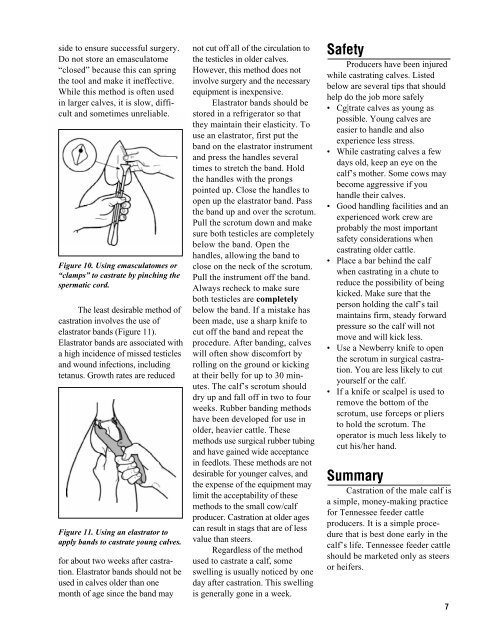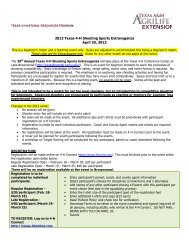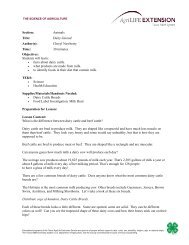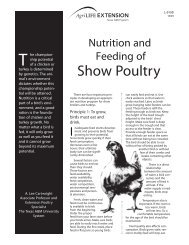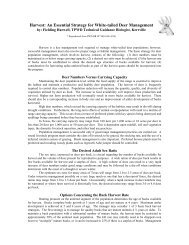Castrating Beef Calves - Walker
Castrating Beef Calves - Walker
Castrating Beef Calves - Walker
- No tags were found...
You also want an ePaper? Increase the reach of your titles
YUMPU automatically turns print PDFs into web optimized ePapers that Google loves.
side to ensure successful surgery.Do not store an emasculatome“closed” because this can springthe tool and make it ineffective.While this method is often usedin larger calves, it is slow, difficultand sometimes unreliable.Figure 10. Using emasculatomes or“clamps” to castrate by pinching thespermatic cord.The least desirable method ofcastration involves the use ofelastrator bands (Figure 11).Elastrator bands are associated witha high incidence of missed testiclesand wound infections, includingtetanus. Growth rates are reducedFigure 11. Using an elastrator toapply bands to castrate young calves.for about two weeks after castration.Elastrator bands should not beused in calves older than onemonth of age since the band maynot cut off all of the circulation tothe testicles in older calves.However, this method does notinvolve surgery and the necessaryequipment is inexpensive.Elastrator bands should bestored in a refrigerator so thatthey maintain their elasticity. Touse an elastrator, first put theband on the elastrator instrumentand press the handles severaltimes to stretch the band. Holdthe handles with the prongspointed up. Close the handles toopen up the elastrator band. Passthe band up and over the scrotum.Pull the scrotum down and makesure both testicles are completelybelow the band. Open thehandles, allowing the band toclose on the neck of the scrotum.Pull the instrument off the band.Always recheck to make sureboth testicles are completelybelow the band. If a mistake hasbeen made, use a sharp knife tocut off the band and repeat theprocedure. After banding, calveswill often show discomfort byrolling on the ground or kickingat their belly for up to 30 minutes.The calf’s scrotum shoulddry up and fall off in two to fourweeks. Rubber banding methodshave been developed for use inolder, heavier cattle. Thesemethods use surgical rubber tubingand have gained wide acceptancein feedlots. These methods are notdesirable for younger calves, andthe expense of the equipment maylimit the acceptability of thesemethods to the small cow/calfproducer. Castration at older agescan result in stags that are of lessvalue than steers.Regardless of the methodused to castrate a calf, someswelling is usually noticed by oneday after castration. This swellingis generally gone in a week.Producers have been injuredwhile castrating calves. Listedbelow are several tips that shouldhelp do the job more safely• Cg|trate calves as young aspossible. Young calves areeasier to handle and alsoexperience less stress.• While castrating calves a fewdays old, keep an eye on thecalf’s mother. Some cows maybecome aggressive if youhandle their calves.• Good handling facilities and anexperienced work crew areprobably the most importantsafety considerations whencastrating older cattle.• Place a bar behind the calfwhen castrating in a chute toreduce the possibility of beingkicked. Make sure that theperson holding the calf’s tailmaintains firm, steady forwardpressure so the calf will notmove and will kick less.• Use a Newberry knife to openthe scrotum in surgical castration.You are less likely to cutyourself or the calf.• If a knife or scalpel is used toremove the bottom of thescrotum, use forceps or pliersto hold the scrotum. Theoperator is much less likely tocut his/her hand.Castration of the male calf isa simple, money-making practicefor Tennessee feeder cattleproducers. It is a simple procedurethat is best done early in thecalf’s life. Tennessee feeder cattleshould be marketed only as steersor heifers.


